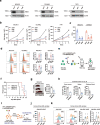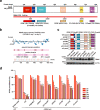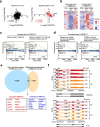RNA-binding protein RBM5 plays an essential role in acute myeloid leukemia by activating the oncogenic protein HOXA9
- PMID: 38216972
- PMCID: PMC10785552
- DOI: 10.1186/s13059-023-03149-8
RNA-binding protein RBM5 plays an essential role in acute myeloid leukemia by activating the oncogenic protein HOXA9
Abstract
Background: The oncogenic protein HOXA9 plays a critical role in leukemia transformation and maintenance, and its aberrant expression is a hallmark of most aggressive acute leukemia. Although inhibiting the upstream regulators of HOXA9 has been proven as a significant therapeutic intervention, the comprehensive regulation network controlling HOXA9 expression in leukemia has not been systematically investigated.
Results: Here, we perform genome-wide CRISPR/Cas9 screening in the HOXA9-driven reporter acute leukemia cells. We identify a poorly characterized RNA-binding protein, RBM5, as the top candidate gene required to maintain leukemia cell fitness. RBM5 is highly overexpressed in acute myeloid leukemia (AML) patients compared to healthy individuals. RBM5 loss triggered by CRISPR knockout and shRNA knockdown significantly impairs leukemia maintenance in vitro and in vivo. Through domain CRISPR screening, we reveal that RBM5 functions through a noncanonical transcriptional regulation circuitry rather than RNA splicing, such an effect depending on DNA-binding domains. By integrative analysis and functional assays, we identify HOXA9 as the downstream target of RBM5. Ectopic expression of HOXA9 rescues impaired leukemia cell proliferation upon RBM5 loss. Importantly, acute protein degradation of RBM5 through auxin-inducible degron system immediately reduces HOXA9 transcription.
Conclusions: We identify RBM5 as a new upstream regulator of HOXA9 and reveal its essential role in controlling the survival of AML. These functional and molecular mechanisms further support RBM5 as a promising therapeutic target for myeloid leukemia treatment.
Keywords: Acute myeloid leukemia; CRISPR screen; Genome editing; HOXA9; RBM5.
© 2023. The Author(s).
Conflict of interest statement
Dr. Chunliang Li is an editorial board member for
Figures








Similar articles
-
Functional interrogation of HOXA9 regulome in MLLr leukemia via reporter-based CRISPR/Cas9 screen.Elife. 2020 Oct 1;9:e57858. doi: 10.7554/eLife.57858. Elife. 2020. PMID: 33001025 Free PMC article.
-
RNA-binding protein PUM2 promotes T-cell acute lymphoblastic leukemia via competitively binding to RBM5 3'UTR with miR-28-5p.Eur J Haematol. 2023 May;110(5):498-509. doi: 10.1111/ejh.13914. Epub 2023 Feb 19. Eur J Haematol. 2023. PMID: 36536516
-
Conditional MN1-TEL knock-in mice develop acute myeloid leukemia in conjunction with overexpression of HOXA9.Blood. 2005 Dec 15;106(13):4269-77. doi: 10.1182/blood-2005-04-1679. Epub 2005 Aug 16. Blood. 2005. PMID: 16105979 Free PMC article.
-
Molecular regulators of HOXA9 in acute myeloid leukemia.FEBS J. 2023 Jan;290(2):321-339. doi: 10.1111/febs.16268. Epub 2021 Nov 19. FEBS J. 2023. PMID: 34743404 Review.
-
Deregulation of the HOXA9/MEIS1 axis in acute leukemia.Curr Opin Hematol. 2016 Jul;23(4):354-61. doi: 10.1097/MOH.0000000000000245. Curr Opin Hematol. 2016. PMID: 27258906 Free PMC article. Review.
References
Publication types
MeSH terms
Substances
Grants and funding
- 2022YFC2502700/Key Technologies Research and Development Program
- 2022YFC25022701/Key Technologies Research and Development Program
- 2022YFC2502702/Key Technologies Research and Development Program
- 82170119/National Natural Science Foundation of China
- BK20210714/Science and Technology Support Program of Jiangsu Province
LinkOut - more resources
Full Text Sources
Medical
Molecular Biology Databases

